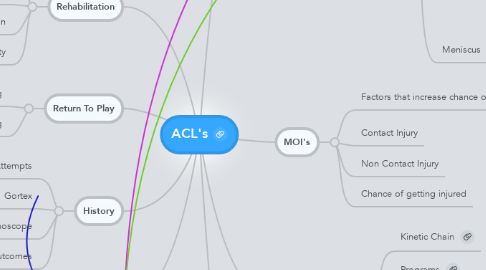
1. Anatomy
1.1. Ligaments
1.1.1. ACL
1.1.1.1. Anterior Cruciate Ligament Originates from deep within the notch of the distal femur
1.1.2. LCL
1.1.2.1. Lateral Collateral Ligament Located on the Lateral Aspect
1.1.3. MCL
1.1.3.1. Medial Collateral Ligament Located on the Medial Aspect
1.1.4. PCL
1.1.4.1. Posterior Cruciate Ligament Originates from the tibia to the medial condyle of the femur
1.2. Tendons
1.2.1. Patellar Tendon
1.2.1.1. Connects the quadriceps tendon to the patella
1.2.1.2. Also connects the patella and the tibia (acts like a ligament)
1.2.2. Quadriceps Tendon
1.2.2.1. connects quadriceps muscles to the patella
1.3. Muslces
1.3.1. Hamstring
1.3.1.1. A group of tendons contracted by three posterior thigh muscles.
1.3.1.1.1. bicep femoris
1.3.1.1.2. semitendonosus
1.3.1.1.3. semimembranosus
1.3.2. Quadricep
1.3.2.1. Protects the anterior cruciate ligaments.
1.3.2.1.1. vastus intermedius
1.3.2.1.2. vastus medialis
1.3.2.1.3. vastus lateralis
1.3.2.1.4. rectus femoris
1.4. Bones
1.4.1. Femur
1.4.1.1. articulation at the hip and the knee
1.4.1.2. Bone of the thigh
1.4.2. Tibia
1.4.2.1. Bone in the front of the knee
1.4.2.2. also known as the shin bone
1.4.3. Fibula
1.4.3.1. non WB bone on the lateral side of the lower leg
1.4.4. Patella
1.4.4.1. Located in the front of the knee
1.4.4.2. also known as the kneecap
1.4.4.3. largest sesmoid bone in the body
1.5. Meniscus
2. MOI's
2.1. Factors that increase chance of injury
2.1.1. women experience bone loss after ACL surgery
2.2. Contact Injury
2.3. Non Contact Injury
2.4. Chance of getting injured
3. Prevention
3.1. Kinetic Chain
3.2. Programs
3.3. Jump and Land Training
3.4. Sport Specificity
3.5. Bracing
4. Functional Anatomy
4.1. Function
4.1.1. Movements
4.1.1.1. Flexion
4.1.1.1.1. action of bending a joint
4.1.1.2. Extension
4.1.1.2.1. action of straightening a joint
4.1.1.3. Internal Rotation
4.1.1.3.1. rotating towards the middle of the body
4.1.1.4. External Rotation
4.1.1.4.1. rotating away from the middle of the body
4.1.1.5. Valgus
4.1.1.5.1. Moving Left
4.1.1.6. Varus
4.1.1.6.1. Moving Right
4.1.1.7. Anterior Translation
4.1.1.7.1. gliding to the front
4.1.1.8. Posterior Translation
4.1.1.8.1. gliding to the back
4.1.2. ACL Purpose
4.1.2.1. Restricts some knee movements
4.1.2.1.1. Prevents Hyperextension
4.1.2.1.2. Prevents internal rotation
4.1.2.1.3. Limits side to side motion
4.1.2.2. Femur

